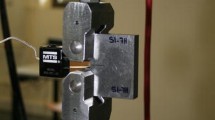Abstract
A procedure for testing concrete beams in three-point bending to determine the fracture energy GF has been proposed by RILEM Technical Committee 50—Fracture Mechanics of Concrete. In the evaluation of the test data the proposal presents a formula for GF in which beam and carried fixture weights are included. Herein it is demonstrated that the effects of these dead-weight forces are presented correctly only (and approximately) for a testing arrangement in which load and beam deformation are both downward. A formula for the case of upward load and deformation is proposed.
Similar content being viewed by others
Abbreviations
- A :
-
Area under load-displacement curve
- A lig :
-
Uncracked ligament of beam
- e, d, u:
-
Subscripts referring to compensated beams, uncompensated beam loaded downward, and uncompensated beam loaded upward, respectively
- F :
-
Centre-point load
- F 1 :
-
Centre-point load which creates the same energy as beam-supported dead loads
- F 2 :
-
Appurtenance self-weight or fixture load
- G F :
-
Fracture energy
- S :
-
Beam span length
- q d S :
-
Beam self-weight between supports=mg
- δ:
-
Displacement
- δ0 :
-
Displacement whenF=0 (downward load) or displacement whenF=F 2+1/2q d S (upward load) for uncompensated beam
- \(\bar \delta _0 \) :
-
Displacement at intermediate load level—sometimes taken at the point of instability on theF−δ trace
- W 0 :
-
Area under load-displacement curve to δ0
- U :
-
Area under load-displacement curve to\(\bar \delta _0 \) Other terms are defined where they first appear in the text
References
RILEM Technical Committee 50-FMC, proposed RILEM recommendation ‘Determination of the fracture energy of mortar and concrete by means of three-point bend tests on notched beams,’Mater. Struct. 18 (106) (1985).
Peterson, P.-E., ‘Crack Growth and Development of Fracture Zones in Plain Concrete and Similar Materials’, Report TVBM-1006 (Division of Building Materials, Lund Institute of Technology, Lund, Sweden, 1981).
Hilsdorf, H. K. and Brameshuber, W., ‘Size effects in the experimental determination of fracture mechanics parameters’, in Application of Fracture Mechanics to Cementitious Composites’, edited by S. P. Shah (Nijhoff, Dordrecht, 1985) pp. 319–360.
Hillerborg, A., ‘The theoretical basis of a method to determine the fracture energyG F of concrete,’Mater. Struct. 18 (106) (1985).
Swartz, S. E. and Yap, Sze-Ting, ‘Evaluation of Proposed Methods to Determine Fracture Parameters for Concrete in Bending’, Report No. 181 (Engineering Experiment Station, Kansas State University, 1986).
Brameshuber, W. and Hilsdorf, H. K., ‘Development of strength and deformability of very young concrete’, in Proceedings of International Conference on Fracture of Concrete and Rock, Houston, Texas, June 1987, edited by S. P. Shah and S. E. Swartz.
Author information
Authors and Affiliations
Rights and permissions
About this article
Cite this article
Swartz, S.E., Yap, S.T. The influence of dead load on fracture energy measurements using the RILEM method. Materials and Structures 21, 410–415 (1988). https://doi.org/10.1007/BF02472320
Issue Date:
DOI: https://doi.org/10.1007/BF02472320




